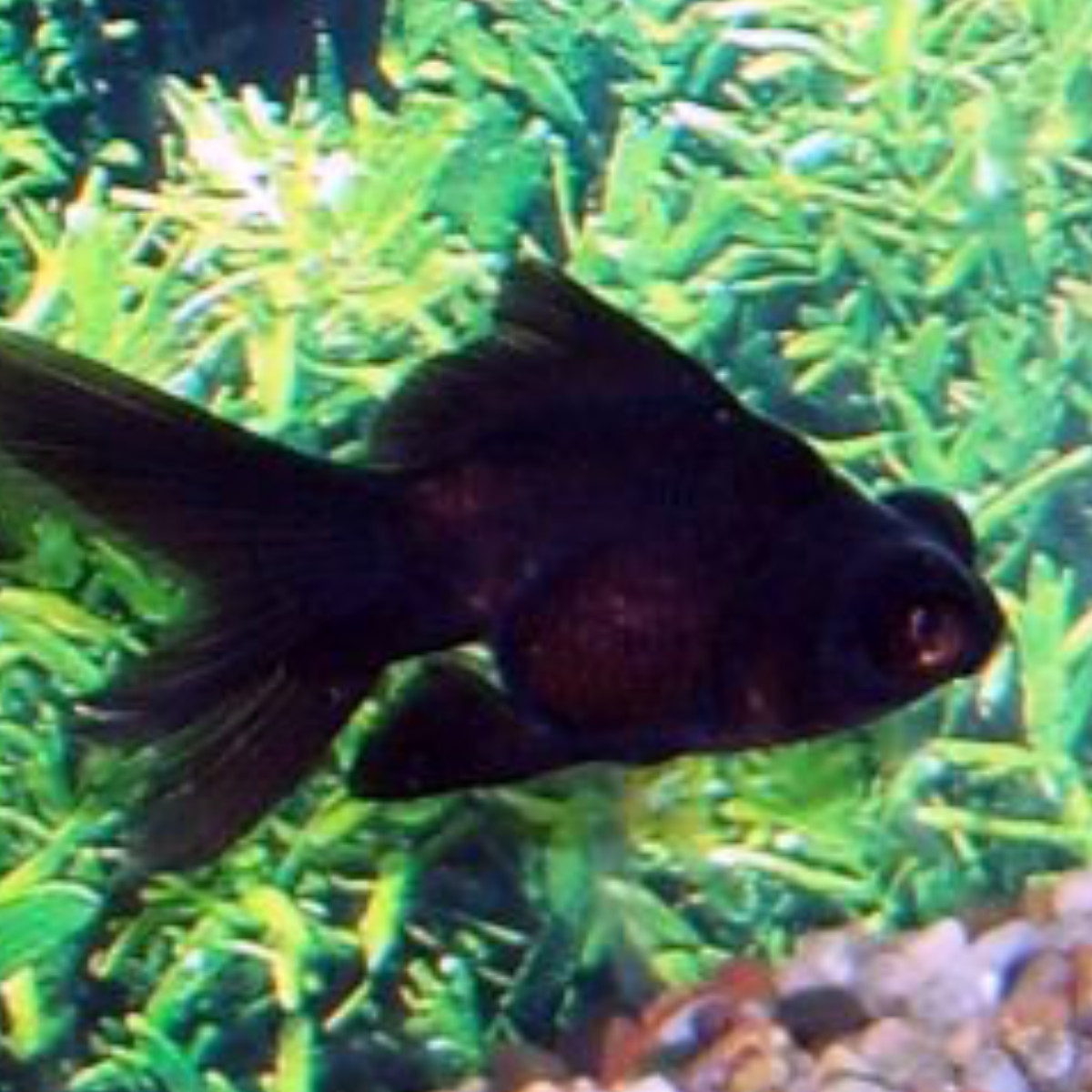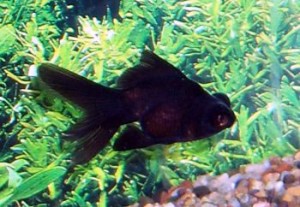GOLDFISH
There are over 100 types of goldfish! All of the goldfish breeds belong to one of two types. The two types are the ORDINARY goldfish and FANCY goldfish. Ordinary goldfish have only one tail, while fancy goldfish have two tails.
To get a better idea of the different types of goldfish (Carassius Auratus that belongs to Cyprinidae family), hare you will find a detailed list about goldfish.
Black Moor Goldfish
Originally Black Moor Goldfish were always black. Recently other colors and variations of the Moor Goldfish have become available:
- red
- red & white
- calico
- black & white (panda moor)
- chocolate
- brown
- blue
- bronze
- lavender
- chocolate
- tricolored
Projecting eyes aside, black moor gold fish have long flowing fins, and deep bodies. Their tail is considered veiltail, and there scales are metallic with a velvet like appearance. That velvety appearance can fade if the black moor reaches old age.
As the Black Moor Goldfish has poor vision they are not generally suited for an outdoor pond. Black Moor gold fish also have a sensitivity to prolonged exposure to low temperatures.
Bubble Eye Goldfish
[caption id="attachment_1179" align="aligncenter" width="280"]
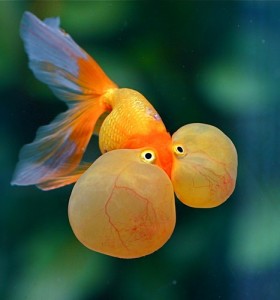 Bubble Eye Goldfish[/caption]
Bubble Eye Goldfish[/caption]Bubble Eye Goldfish, otherwise known as suihogan in Japan, is instantly recognizable small twin tailed fancy variety of goldfish. This goldfish has eyes that are nearly completely surrounded by a fluid filled sac. The bubble eye has an egg shaped body, and does not have a dorsal fin. Coloration, like most goldfish can be varied, but bubble eye goldfish are typically metallic red/orange. Other color variations can include:
- red
- red-and-white
- black
- gold
- calico
Bubble Eye goldfish, due to vulnerability of the eye sacs, are best kept in their own aquarium with no rocky, or pointy, furnishings. The bubble eye goldfish are relatively poor swimmers due to their impaired vision, and can not compete with more active goldfish. Their 'bubbles' can also be easily damaged by being sucked into the filter intake. Keep the Bubble Eye goldfish in a tank with other goldfish.
Celestial Eye Goldfish
[caption id="attachment_1181" align="aligncenter" width="300"]
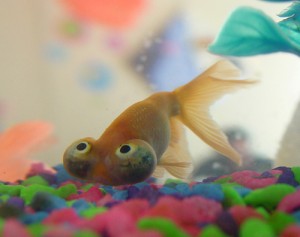 Celestial Eye Goldfish[/caption]
Celestial Eye Goldfish[/caption]The fancy Celestion eye goldfish have a pair of characteristic telescope eyes which are turned upwards. Celestial gold fish are part of a realtively small group of goldfish without a dorsal fin. They can vary widely in color, with either metallic of nacreous scales. Due to many issues that the upward oriented eyes, celestial gold fish are best kept in a tank with out celetial eyes. Young Celestials will have normal eyes that protrude slightly sideway and then over a period of 6 months will turn upwards.
Celestial Eye Goldfish should only be kept in aquariums with other celestial goldfish.
Comet Goldfish
[caption id="attachment_1165" align="aligncenter" width="300"]
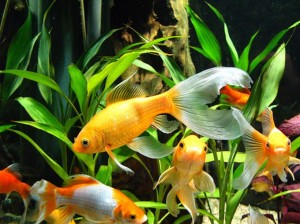 Comet Goldfish[/caption]
Comet Goldfish[/caption]Comet gold fish have an elongated body, with equally curved dorsal and ventral contours. Unlike the common goldifsh, it is not deep or heavily bodied. While many color option are available the most common colors are:
- Red-Orange
- Lemon Yellow
The main feature of comet variety in the large, deeply forked caudal fin, that can be almost as long as the body itself.
It requires plenty of swimming room and can swim exceptionally fast for short periods of time. Comet goldfish can be kept in a pond outside.
Common Goldfish
[caption id="attachment_1166" align="aligncenter" width="280"]
 Common Goldfish[/caption]
Common Goldfish[/caption]It has a stock body with equally convex dorsal and ventral contours. The body is a brilliant metallic orange-red or yellow, and this vivid color extends into the fins. The dorsal fin has a long base, and the anal and caudal fines are not divided, and the caudal fin is moderately forked. Young fish are dark in color when hatched, and change to adult coloration at around one year of age - although not every fish changes color.
This fish is very hardy and does not need special care. Not only are they a great community fish but they are great scavengers as well. It is really not necessary to add other scavengers or other bottom feeders to the aquarium when you have goldfish. Common Goldfish are suitable for ponds outside all year round.
Demekin Goldfish
[caption id="attachment_1229" align="aligncenter" width="300"]
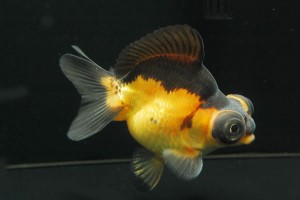 Demekin Goldfish[/caption]
Demekin Goldfish[/caption]A cross between a ryukin and a telescope goldfish. They have a high arched back with telescoped eyes.
Fantail Goldfish
[caption id="attachment_1167" align="aligncenter" width="300"]
 Fantail Goldfish[/caption]
Fantail Goldfish[/caption]The fantail has a relatively short body with deep, short caudal peduncle. Its body coloration is variable, depending on the scale formation and pigmentation. THe dorsal fin is held high, and in good specimens it should be around half the body depth. It has double anal and caudal fins.
The fantail can be kept in an outdoor pond all year round, providing the water is deep enough to ensure a warm layer at the bottom where it can lie dormant.
Jikins Goldfish
[caption id="attachment_1231" align="aligncenter" width="300"]
 Jikins Goldfish[/caption]
Jikins Goldfish[/caption]Slender in shape just like the common goldfish but the tail is completely spil outward. The color of this fish only comes in one kind. the body of the fish should be white and the fins, lips and gill plates should be red to orange.
The Jikin is a perfect pond fish, and will do wonderfully outside. I am thinking that the pond in fact would be the best environment for a jikin - the natural sunlight and ever present algae brings out the bright red color points to their fullest potential. Of course, a tank is a good place for the jikin as well, him not growing all that gigantic (around 23cm (9 inch)) does have its advantages.
Lionchu Goldfish
[caption id="attachment_1182" align="aligncenter" width="300"]
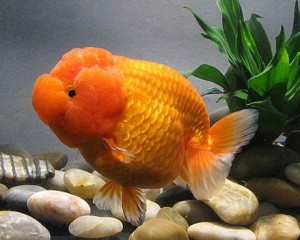 Lionchu Goldfish[/caption]
Lionchu Goldfish[/caption]The Lionchu, or lionhead-ranchu, is a result from crossbreading a lionhead and a ranchu. A fancy goldfish criteria for the lionchu brings together the traditional side view characteristic of both the ranchu, and the lionhead. The deep body, curved back and tail placement of the ranchu have merged with the lionheads large headgrowth. Lionchus also lack a dorsal fin. Lionchu can grow to a length of 15cm (6inch) when mature. They need to live in a cool but not cold water environment that is kept between 18-25C (65-78F).
Lionhead Goldfish
[caption id="attachment_1183" align="aligncenter" width="300"]
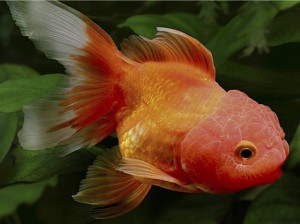 Lionhead Goldfish[/caption]
Lionhead Goldfish[/caption]The short, egg shaped body of the lionhead doesn not have a dorsal fin. In some respects the lionhead is simliar to the red-cap oranda, as both varieties have a raspberry-like growth on the head. The caudal fin should be held stiffly, and not allowed to drop.
The lionhead is best kept in the indoor aqaurium, where its colorful feautres can be easily seen.
Oranda Goldfish
[caption id="attachment_1168" align="aligncenter" width="300"]
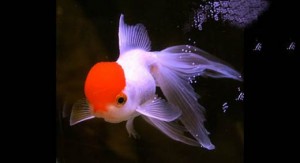 Oranda Goldfish[/caption]
Oranda Goldfish[/caption]The red-cap oranda has a short, deep body, with a short slightly down tunred caudal peduncle. Some strains have a white body with a red coloration restricted to the raspberry-like growth on the head, known as the "wen." The dorsal fin is held high, and the anal and caudal fins are double.
Like many of the goldfish strains with more fully developed fins, the oranda needs very clean water conditions to prevent fin damage and deterioration.
Panda Moor Goldfish
[caption id="attachment_1184" align="aligncenter" width="300"]
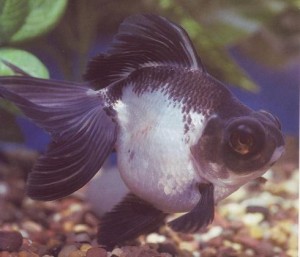 Panda Moor Goldfish[/caption]
Panda Moor Goldfish[/caption]The panda moor is a fancy goldfish with a characteristic black-and-white color pattern and protruding eyes. Panda moors have delicate projecting eyes, deep bodies, and long flowing finnage. Like any other moor goldfish, pandas can grow very large. They are metallic-scaled and veiltailed. Young moors resemble bronze fantails and their protruding eyes gradually develop with age. They sport a velvety appearance in maturity. However, they may loose this velvet-like appearance with increasing age.
Because of their delicate eyes and poor vision, pandas are kept in an aquarium without sharp or pointed objects. They are sensitive to low water temperature levels.
Pearlscale Goldfish
[caption id="attachment_1185" align="aligncenter" width="300"]
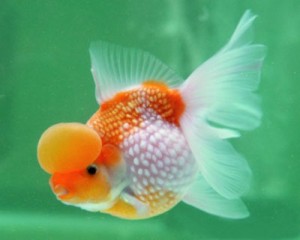 Pearlscale Goldfish[/caption]
Pearlscale Goldfish[/caption]The scales on this fish have a pearl-lke appearance: this is due to each scale having a domed, or raised, center. These fish are usually metallic or calico in color, and in most other respects, the strain appears to conform to the usual rounded body shape and "double" anal and caudal fins of the twin tailed group of goldfish.
Pearlscales are very sensitive to cold water and should not be exposed to temperature readings below 13C (55F).
Pompom Goldfish
[caption id="attachment_1186" align="aligncenter" width="300"]
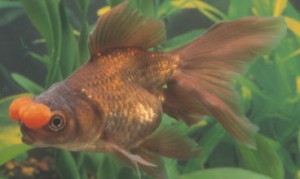 Pompom Goldfish[/caption]
Pompom Goldfish[/caption]A fancy goldfish, Pompoms have bundles of loose fleshy outgrowths on each side of the head, between the nostrils. With a similar body shape and finnage to the lionhead, the pompom supports it's nasal outgrowths and not the headgrowth of the lionhead. These outgrowths are developed through selective breeding of the pompom.
Ranchu Goldfish
[caption id="attachment_1169" align="aligncenter" width="300"]
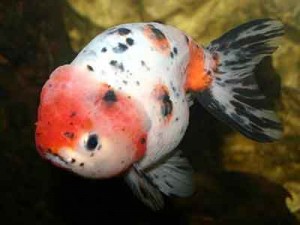 Ranchu Goldfish[/caption]
Ranchu Goldfish[/caption]Refered to as the "King of Goldfish" by the Japanese, the Ranchu is a hooded variety of fancy goldfish. The egg shaped body of the Ranchu does not have a dorsal fin as a breeding standard. Much like the lionheads, a ranchu back should be arched and not flat. The head of the ranchu goldfish is probably the most prominent feature. While the headgrowth can take at least a year to develop, it should seem to begin from the bottom of the gill cover and move upward.
Ranchus are available in:
- orange
- red
- white
- red-and-white
- blue
- black
- black-and-white
- black-and-red
- natural
- chocolate
Ranchus with a pale-yellow bodies and bright red heads are considered rare.
Ranchus are well-adapted to water quality and pH fluctuations.
Ryukin Goldfish
[caption id="attachment_1172" align="aligncenter" width="300"]
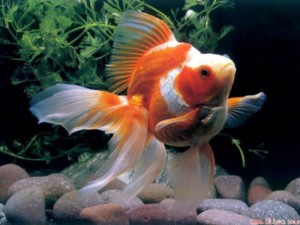 Ryukin Goldfish[/caption]
Ryukin Goldfish[/caption]A very hardy and attractive variety of goldfish, the ryukin has a pointed head and a prounounced hump on the back behind the head. Varieties are long or short finned, triple or quadruple tail, with a high dorsal fin and caudal fin that is often twice as long as the Ryukin body. The Ryukin goldfish is one of la rather large goldfish reaching 20-25cm (8-10 inch) when good care and water mass available.
Ryukin goldfish are available in a variety of colors, including;
- deep-red
- red-and-white
- white
- calico
Ryukin goldfish is suitable for ponds outside where there in so much more water mass available.
Shubunkin Goldfish
[caption id="attachment_1173" align="aligncenter" width="300"]
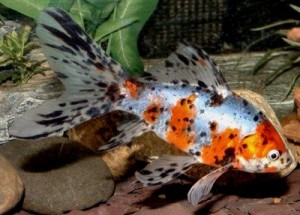 Shubunkin Goldfish[/caption]
Shubunkin Goldfish[/caption]This is similar to the common goldfish in body shape. Its coloration should include a combination of black, red, purple, blue, and brown, all appearing beneath nacreous or matte scales.
The London shubunkin has the ame finnage as the common goldfish, and the Bristol shubunkin has a large caudal fin with rounded lobes: this should be carried without dropping.
This variety is suitable for an aquarium or pond.
Telescope Eye Goldfish
[caption id="attachment_1174" align="aligncenter" width="300"]
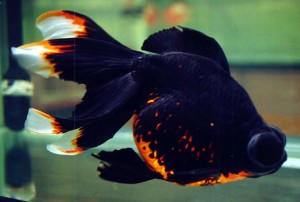 Telescope Eye Goldfish[/caption]
Telescope Eye Goldfish[/caption]Very similar to the Ryukin, the Telescope Eye has the obviously enlarged projecting eyes. The telescope eye goldfish has a deep body and long flowing fins. Also know as Demekins, Telescope eyes can grow quite large, and are available in the following colors:
- red
- red-and-white
- calico
- black-and-white
- chocolate
- blue
- lavender
- chocolate-and-blue
- black
Due to the telescope eye's poor vision, is more suitable for aquarium without sharp and pointed objects than ponds.
Tosakin Goldfish
[caption id="attachment_1175" align="aligncenter" width="300"]
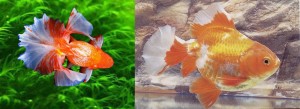 Tosakin Goldfish[/caption]
Tosakin Goldfish[/caption]Tosakins are a more rare breed of goldfish that are typically found in Japan. With a body shape like the Ryukin, the Tosakins tail fins open and spread flat causing the front ends to curl under.
Tosakin goldfish are best viewed from above, showing their pointed head, round trunk, and flat half circled tail that curls under.
Tosakin goldfish can be found in the following colors:
- Red
- Red and White
- Iron Black
- Calico
Because the Tosakin is a weak and poor swimmer Tosakin Goldfish should be kept in shallow water with no current. Slight changes in water chemistry can be very harmul, and Tosakin Goldfish are very weak throughout their first year.
Veiltail Goldfish
[caption id="attachment_1177" align="aligncenter" width="260"]
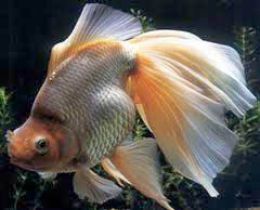 Veiltail Goldfish[/caption]
Veiltail Goldfish[/caption]The veiltail variety of goldfish has a modified Ryukin shaped body that is deep and round with a lengthy and graceful tail. There is no forking, or indentation, between the lobes of the square tail of the Veiltail goldfish. The caudal fin length should be equal to at least the length of the body of the fish. The anal fins should also be paired and relatively longer than other types of goldfish. The tail of the Veiltail is often held at a downwards angle, making it truly look like a veil.
Veiltails are less hardy than even other fancy goldfish, and therefore should never be over wintered in outdoor ponds. Care should be taken whenever they are placed in ponds as rapid temperature drops can lead to severe stress and loss of these delicate fish. They are also much more susceptible to disease and parasites.
Goldfish Genealogical Tree
Further more if you want to explorer the Goldfish forms and collours, the map bellow can help you:
[caption id="attachment_1188" align="aligncenter" width="300"]
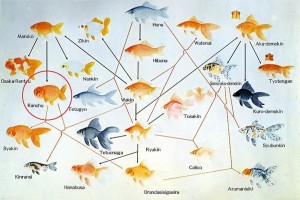 Goldfish Genealogical Tree[/caption]
Goldfish Genealogical Tree[/caption]KOI FISH
Koi are beautiful 'ornamental' versions of the common carp species (Cyprinus carpio).
Apart from their beauty and sturdiness as fish, koi has become legendary because of the fact that they can grow to very large sizes, and is limited relatively by the size of the pond that they reside in. And also they are renowned for their ability to live very long years.
Heres a chart of the popular koi fish for reference:
[caption id="attachment_1245" align="aligncenter" width="240"]
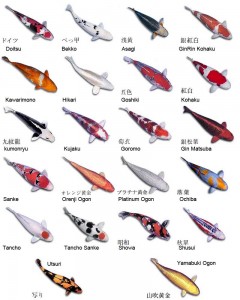 Koy fish names[/caption]
Koy fish names[/caption] 

